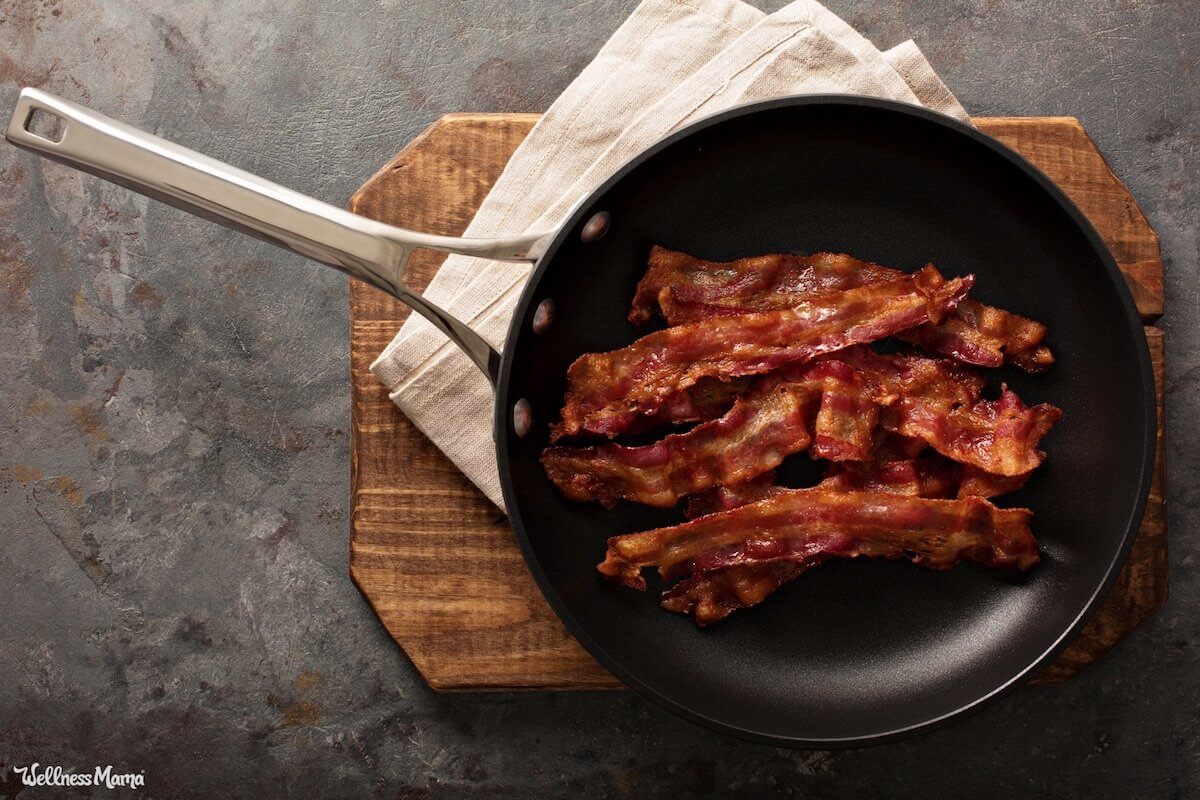When trying to make diet changes in order to improve health, nitrates are one of the additives most of us try to avoid. In general, additives and preservatives aren’t ideal, and we want to avoid them when possible.
But in the healthy living community there are many differing opinions on nitrates, whether we should eat them, when, how much, and whether we should really worry about them at all. Many of us pay more for nitrate-free meats. The question is, is it worth it?
Are Nitrates in Food Bad?
Before we get into nitrates and nitrites, it’s important to understand what cured and uncured meat is. Cured meat is cured with sodium nitrate, or sodium nitrite, most often created in a laboratory. Uncured meat is still cured, but using only celery juice).
Nitrates vs. Nitrites
Nitrates occur naturally and aren’t harmful. In fact, nitrates are essential to good health, and the body makes plenty of nitrates every day.
When you ingest nitrates, they can turn into nitrites in the mouth or stomach. But nitrites aren’t inherently bad either. Nitrites can turn into nitric oxide in the body. One health benefit of nitric oxide is that it helps improve oxygen circulation and blood pressure.
The source of concern over the nitrate content in food stems from a 1970s study that connected nitrates to cancer in rats. However, once the study was peer-reviewed, nitrates were officially debunked as a carcinogen and no other studies have been able to find a link between dietary nitrate intake and cancer.
The amount of nitrates that are found in cured meats (the main source of nitrates we worry about) is fairly low, too. In fact, there are more nitrates in vegetables and human saliva than in cured meats. The CDC estimates that 80 percent of dietary nitrates are from vegetables.
Obviously, vegetables are an important part of a healthy diet, so we shouldn’t stop eating them. (Honestly, most of us should probably eat more vegetables!) When we talk about nitrates from vegetables, they are absolutely nothing to worry about.
The reason we don’t need to worry is that vegetables also contain vitamin C or other antioxidants. This encourages nitrites to convert into a healthy nitric oxide, rather than the concerning nitrosamine.
Nitrosamine
Unlike nitrates or nitrites, there is a link between nitrosamine and certain cancers. To really solidify these findings, larger studies are still needed.
Cured or uncured meats are more likely to contain nitrosamines (or encourage their conversion in the body). Meats contain amines that change nitrites into nitrosamine. This is more likely to happen when you cook cured meats at high temperatures.
To sum up, nitrates and nitrites aren’t inherently bad. However, nitrates and nitrites in processed meats are much more likely to turn into nitrosamines than other sources of nitrates.
Synthetic Nitrates vs. Naturally Occurring
While on the surface it seems like uncured meats (those cured with naturally occurring nitrates from celery juice) would be a better choice than meats cured with chemical nitrates, this may not be the case.
Common sense tells us that something that’s created in a lab may not react the same way in the body as something that is formed naturally. But there’s no research that compares the effects on the body of naturally “uncured” meat versus cured meat. So it’s unclear if one is really “better” than the other.
However, chemically cured pork may be safer than “uncured” pork in one respect. Chemical curing kills the disease trichinosis, but celery juice curing does not kill it.
Yet another angle to consider is that the USDA caps the number of nitrates that can be used in cured meats, but they do not regulate nitrates from celery juice in “uncured” meats. So we could be getting much more nitrates from “uncured” meats than from cured ones.
All of that being said, I still see uncured meats as a better choice (on occasion) because they are more likely to be higher quality meats with fewer other food additives. The reason is that people who buy uncured meats also prefer no antibiotics, no additive meats, organic foods, and companies are marketing uncured meats to these people.
What to Do About Nitrates in Food
Based on research, nitrates and nitrites aren’t a health risk I’d sit up worrying about at night. Though there is some concern about nitrates ultimately turning into nitrosamine, there are some ways to reduce the risk and still enjoy an occasional grass-fed hot dog.
- Reduce intake of cured/uncured meats – As with any food, variety is important and cured or uncured meats shouldn’t be a daily dietary staple (cue groans from my husband). Use common sense and watch your daily intake of meat products.
- Heat cured meats on low temperatures – Slow cooking can reduce nitrosamine conversion and increase beneficial nitric oxide conversion instead. Use these tips when grilling.
- Eat with vitamin C and other antioxidants – Since the 1970s, the USDA requires companies to add vitamin C to cured meats to protect against cancer risk. Adding additional vitamin C to your meal may reduce risks further. For example, eating bacon and eggs with sautéed vegetables for breakfasts adds some vitamin C (and is a good way to sneak in veggies in the morning!).
This article was medically reviewed by Dr. Scott Soerries, MD, Family Physician and Medical Director of SteadyMD. As always, this is not personal medical advice and we recommend that you talk with your doctor.
What’s your story? Do you avoid nitrates, eat them in moderation, or choose not to worry at all? Share below!



Leave a Reply